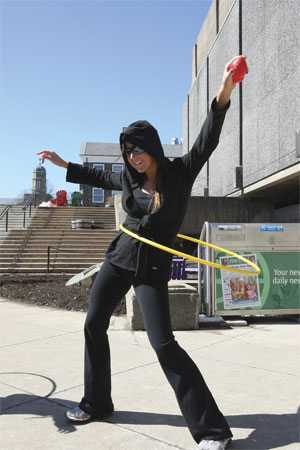 |
| Fourth-year recreational management student Katie Ozolins stops for a little hula hoop. (Nick Pearce Photo) |
A group of onlookers gather at a picture window in the Henry Hicks building early Monday morning looking down at students jumping rope on the sidewalk. The students are laughing and having fun in spite of the cold and their giggles come out in great white plumes.
âWhat the heckâs going on?â we wonder, staring down at the students. But itâs not recessâitâs a carefully orchestrated play break involving students in the Recreation Management program.
Fourth-year student Robert Craig and six of his classmates are involved in organizing and implementing what he calls Random Acts of Play. Over the past term, the students staged fun leisure activities around campus; they encouraged other students to join in if they saw them jumping rope, playing hopscotch and hula hoop or tossing a ball.
âRandom Acts of Play is a student-run initiative to help elevate Dal to its next level of greatness by engaging students in just a few moments of meaningful play,â says Mr. Craig, who got the idea while attending a recreation conference in the U.S.
âWe want to change the way students and faculty perceive play and challenge them to begin incorporating play into their everyday life,â he continues.
His professor is all for it.
âItâs OK to stop and have fun, itâs OK to stop and jump rope, itâs OK to play hopscotch or to toss a ball, just because,â says Barbara Hamilton-Hinch, assistant professor of leisure studies, in the School of Health and Human Performance. Play is important to help wake up body and mind and re-energize.
For a recent study, researchers placed a large red ball in an open area outside; they watched as young kids came up and touched the ball, bounced off the ball, or kicked it around â while adults simply walked around it.
âItâs easy to see that a little bit of leisure recreation can change your whole day,â says Prof. Hamilton-Hinch. âBut sometimes, as people get older, we think playing is just for children.â
